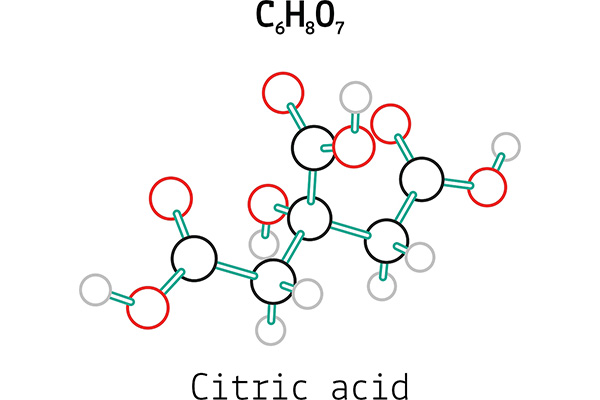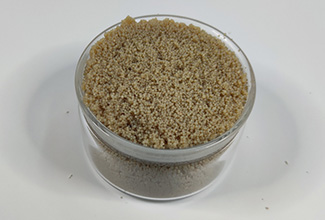Weak Base Macroporous Anion Exchange Resin in Citric Acid Extraction Application
The scientific name of citric acid is 2-hydroxypropane-1, 2, 3-carboxylic acid. Citric acid has a wide range of applications in industrial fields such as food, medicine and cosmetics. The production of citric acid is mainly through biological fermentation. In the process of fermentation, impurities such as salt and pigment will inevitably be generated. It is necessary to pass the necessary refining process to realize the removal and purification of citric acid to meet the relevant standard requirements.
The ion-exchange resin functional process is a very effective and mature technology in the desalination and decolorization of citric acid, and it is widely used in the industrial production of citric acid. However, the high osmotic pressure of citric acid will cause repeated expansion and contraction of the resin during the refining process, and make the resin withstand huge osmotic pressure, especially for anion exchange resins. Reduced resin life and increased costs. This has also become a common problem that plagues the development of the industry, and there is a strong demand for solutions.
In response to the specific problems and difficulties in this industry, COMCESS has launched C330 (701) weak base macroporous anion exchange resin for desalination and decolorization with narrow particle size distribution, good penetration resistance and high exchange capacity. The resin has strong processing capacity, low citric acid loss rate, easy regeneration, low reagent consumption, high mechanical strength, long service life, and higher impurity removal accuracy. Its industrial operation has been highly affirmed and recognized by customers.
Product advantages and features:
(1) The volume exchange capacity is large, which can significantly reduce the production cost of the enterprise;
(2) The exchange speed is fast and the ion removal precision is high, so that the exchange capacity of chloride and sulfate is stronger and the precision is better;
(3) Special white ball process, the resin skeleton has better resistance to high-concentration organic acid osmotic pressure, and still has good mechanical strength after long-term repeated regeneration.
(4) The resin channel is uniform, easier to regenerate, has a long service cycle, a short process flow, easy operation, and is easy to realize automatic control, which is suitable for industrialized citric acid production of scale I.
(5) The resin particle size is more uniform, which can ensure better hydraulic performance and lower bed pressure drop during operation, especially suitable for continuous separation systems with large pressure and load during operation.
The ion-exchange resin functional process is a very effective and mature technology in the desalination and decolorization of citric acid, and it is widely used in the industrial production of citric acid. However, the high osmotic pressure of citric acid will cause repeated expansion and contraction of the resin during the refining process, and make the resin withstand huge osmotic pressure, especially for anion exchange resins. Reduced resin life and increased costs. This has also become a common problem that plagues the development of the industry, and there is a strong demand for solutions.

In response to the specific problems and difficulties in this industry, COMCESS has launched C330 (701) weak base macroporous anion exchange resin for desalination and decolorization with narrow particle size distribution, good penetration resistance and high exchange capacity. The resin has strong processing capacity, low citric acid loss rate, easy regeneration, low reagent consumption, high mechanical strength, long service life, and higher impurity removal accuracy. Its industrial operation has been highly affirmed and recognized by customers.
Product advantages and features:
(1) The volume exchange capacity is large, which can significantly reduce the production cost of the enterprise;
(2) The exchange speed is fast and the ion removal precision is high, so that the exchange capacity of chloride and sulfate is stronger and the precision is better;
(3) Special white ball process, the resin skeleton has better resistance to high-concentration organic acid osmotic pressure, and still has good mechanical strength after long-term repeated regeneration.
(4) The resin channel is uniform, easier to regenerate, has a long service cycle, a short process flow, easy operation, and is easy to realize automatic control, which is suitable for industrialized citric acid production of scale I.
(5) The resin particle size is more uniform, which can ensure better hydraulic performance and lower bed pressure drop during operation, especially suitable for continuous separation systems with large pressure and load during operation.
Related Products
-
 Boron Absorbing Resin Macroporous Ion Exchange Chelating ResinAppearance: Creamy to beige opaque beadsIonic form: Free baseVolume complete exchange capacity(mmol/ml): ≥0.80
Boron Absorbing Resin Macroporous Ion Exchange Chelating ResinAppearance: Creamy to beige opaque beadsIonic form: Free baseVolume complete exchange capacity(mmol/ml): ≥0.80 -
.png) Anionic Polyacrylamide ResinPurity : 99.9%Color : WhiteMelting Point : >150°℃
Anionic Polyacrylamide ResinPurity : 99.9%Color : WhiteMelting Point : >150°℃ -
 D005 Catalyst ResinAppearance: Gray opaque spherical particles.Ionic form:H+Volume complete exchange capacity(mmol/ml):≥4.7
D005 Catalyst ResinAppearance: Gray opaque spherical particles.Ionic form:H+Volume complete exchange capacity(mmol/ml):≥4.7
Message

